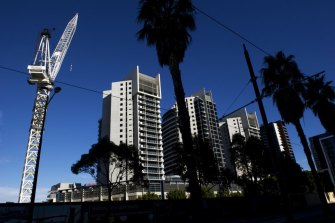When your kids grow up, where are they going to live?
Being a new dad myself, it is a question that seems particularly uncertain. If you have teenagers, it’s probably only a matter of time until your kids will want their own space. But if they choose to stay in Melbourne where exactly would they be able to afford?
When your kids grow up, where are they going to live?Credit:Gabriele Charotte
With Australia’s ongoing housing crisis, the answer is likely one of three possibilities: the outer suburban fringe, a small city apartment or living with you indefinitely. Virtually everything else has become too expensive for young singles and families to afford.
Many politicians and economists suggest the answer to this problem is increasing housing supply, but Australian cities are already among the worst offenders for urban sprawl globally. And by continuing the sprawl, we are making permanent reductions in productive farmland and urbanising areas of environmental value.
The suburbs we build also create unsustainable and unachievable transport infrastructure demands, increasing the cost of living and time pressures for those living on the fringes. Those residing in Tarneit, Point Cook or Clyde North will know well how time-consuming and frustrating travel can be, with almost every trip involving congested roads.
So how can we increase housing supply without contributing to these issues and lining the pockets of property developers? If we are serious about solving this issue, we must level the playing field for the types of housing being built in our existing suburbs.
Specifically, we need to promote an increase in density through family-sized, suburban apartment buildings. This type of building has two storeys and a basement, surrounded by garden on all sides and can sit comfortably alongside single dwellings.
In most cases, if you have a piece of land in suburbia of at least 500 square metres, you are entitled to build a house on it without seeking council planning permission. This house can be very large and be any style you like. It could be fluorescent pink, an imitation French palace or a mansion reminiscent of the White House. If it fits within a few basic parameters, you can head straight for a building permit and construction.
You can have as many people as you like living in your palace, park as many cars as will fit and entirely concrete the backyard. It is your home after all. Those familiar with suburbs such as Balwyn will have experienced this rapid replacement of old homes with new mansions complete with imitation European facades.
However, if you would instead like to build a two-storey apartment building with six or so homes within it, this automatically requires a planning permit. It doesn’t matter if the external envelope is identical to a single home, any apartment building must go through this process.
We should not be treating two-storey, eight-storey and 30-storey buildings in the same way.Credit:Jessica Shapiro
This might seem like appropriate oversight, but the process adds a minimum of six months to the development process and opens the application to a challenge at VCAT that could add another 12 months and tens of thousands in legal fees.
In the planning process, the family-sized apartment building will be evaluated for things like neighbourhood character and visual bulk, tests that simply do not apply to single dwellings. These tests are vital for developments that are more intensive, however we need to be far more nuanced with the idea of what an apartment building is. We should not be treating two-storey, eight-storey and 30-storey buildings in the same way. Clearly the two-storey version has far more in common with our suburban dwellings than residential towers, and it should be treated as such.
If the two-storey suburban apartment building in established middle- and inner-ring suburbs was exempt from planning in a similar way to single dwellings, it would reduce the risks and costs associated with providing this kind of housing. Additional public interest safeguards such as compliance with the Better Apartments Design Standards could be assessed at the building permit stage and therefore not add risk or time to the development. This would ensure we are not sacrificing liveability for affordability.
This regulatory change would also help curb the worst excesses of NIMBYism. While it is clearly appropriate for people to have their say on tower-type apartment developments in their immediate vicinity, we need to be realistic about the fact all neighbourhoods will have some change over time.
We should be correcting the imbalance between the rights of individual property owners to restrict change, and the public good of allowing some change to provide more diverse housing options for the community.
What should matter is the overall height, intensity, and design quality of a proposal, not that the proposed dwellings are apartments. In fact if gentle density were adopted more widely, the need and demand for higher density apartment towers would be significantly reduced.
The benefit of empowering this increase is that it will keep families and communities together. Your kids will have the option of living in the same community without necessarily living under the same roof.
Diversity in suburban housing options also benefits those looking to downsize. Politicians love to talk about providing financial incentives for the elderly to downsize, however if smaller homes do not exist in their suburb, it becomes a non-starter.
So rather than have young families flung to the edges of the city and the elderly feeling trapped within their ageing family dwellings, we need to give people real options for where and how they live.
This is the liveability prize that we must not let go. It is more important than being able to object to a two-storey proposal next door and it is more important than allowing suburbs to remain either fixed in time or the dominant habitat of the French provincial mansion.
Most Viewed in National
From our partners
Source: Read Full Article


